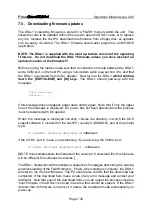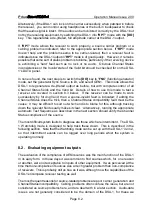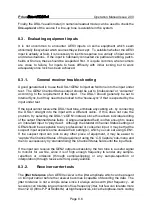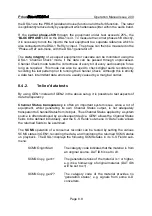
Prism
Operation Manual Issue 2.00
Page 8.1
8.
DSA-1 test and measurement techniques
This section describes some typical ways in which the DSA-1 might be used. The
discussions in this section are intended to provide a general understanding of the test
and trouble-shooting strategies which are appropriate to different problems and
situations, rather than an exhaustive list of the capabilities of the DSA-1 which are
covered elsewhere in this manual.
A basic knowledge of the AES3 interface standard has been assumed, including the
concepts behind various 'problem issues'. This subject is covered to an adequate level
in appendix A, and the reader is referred here in case of difficulty. Likewise a familiarity
with the operation of the DSA-1 is assumed.
8.1. System trouble-shooting
The later sections of this chapter are divided between equipment inputs, outputs,
cabling etc. If you are in a system trouble-shooting situation, it is important first to
establish where in the program chain the problem exists and whether or not an AES3
interface is to blame. It is equally often the case that some other equipment fault or
operational error is responsible.
Even when a particular interface has been implicated, it may not be easy to know
whether a carrier or a data problem exists, or whether the sourcing or receiving
equipment or the cabling is to blame.
In general, intermittent and audio-degradation failures are generally carrier-related
whereas 'hard' or total failures are likely to involve incompatibility of ancillary data such
as Channel Status. However, there are many interesting exceptions which prove the
validity of this rule!
If you suspect a particular AES3 interface, a good first step is to patch the DSA-1 'in-
line' (connect the source to the DSA-1's appropriate DI, and the DSA-1's DO to the
receiver). If you have significant cabling, patch-fields, Krones etc. in the path, it is best
to patch the DSA-1 in just before the receiver.
Having patched in the DSA-1, select the appropriate input and see if the DSA-1 can
receive the signal. The DSA-1 can receive carriers which would be unacceptable to
most other equipment, and it can receive data irrespective of ancillary data such as
Channel Status and Validity flags. If the DSA-1 can't receive the carrier (i.e. the 'FAIL'
LED remains lit) then a catastrophic source carrier fault is indicated; however, before
assuming this, repatch the DSA-1 at the transmitter side of any cabling, patch-fields,
Krones etc. to eliminate these first. If it still looks like a source equipment problem,
refer to section 8.2 below. Otherwise, if the source now appears sound without all the
interconnections in between, try section 8.5.
















































